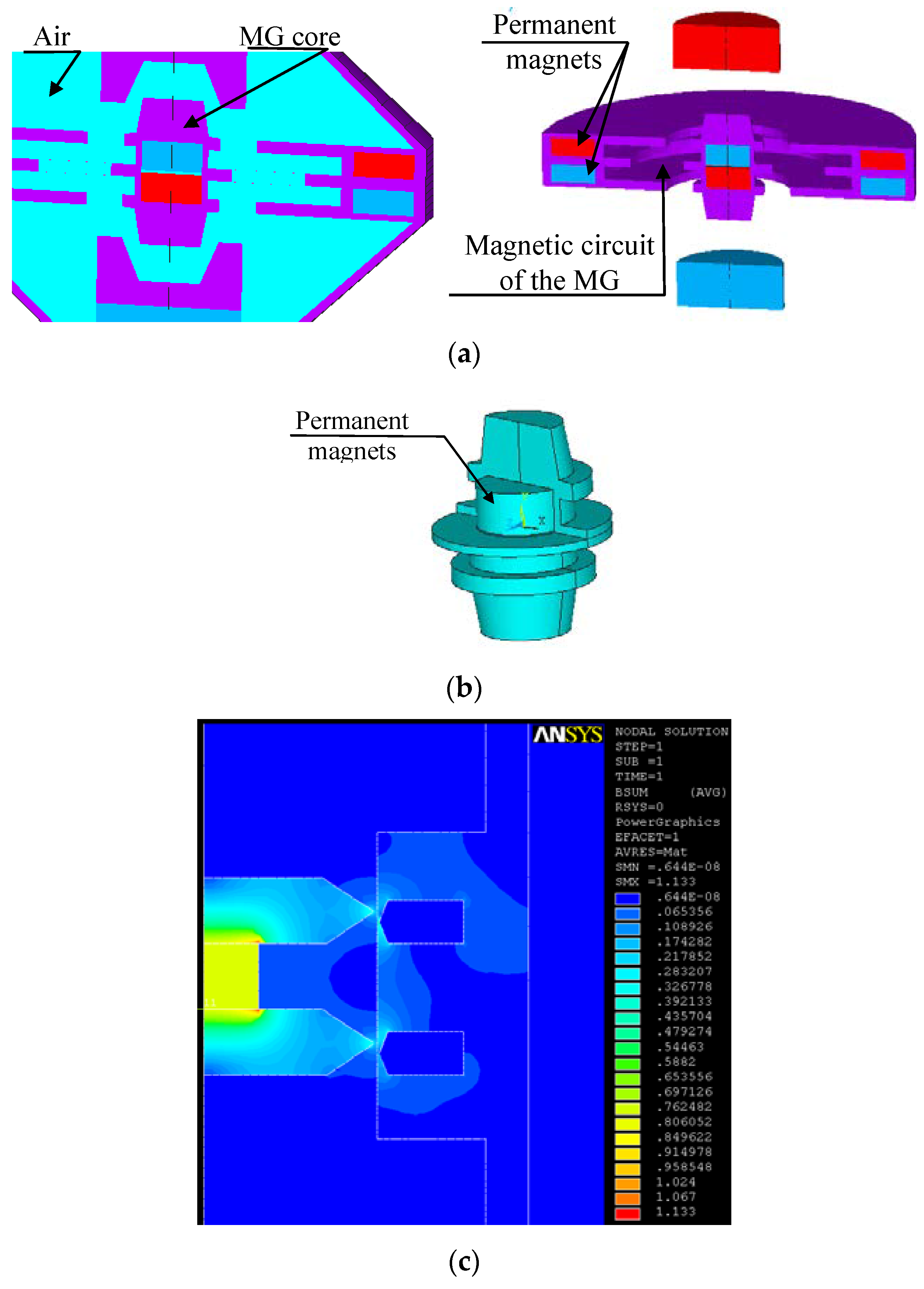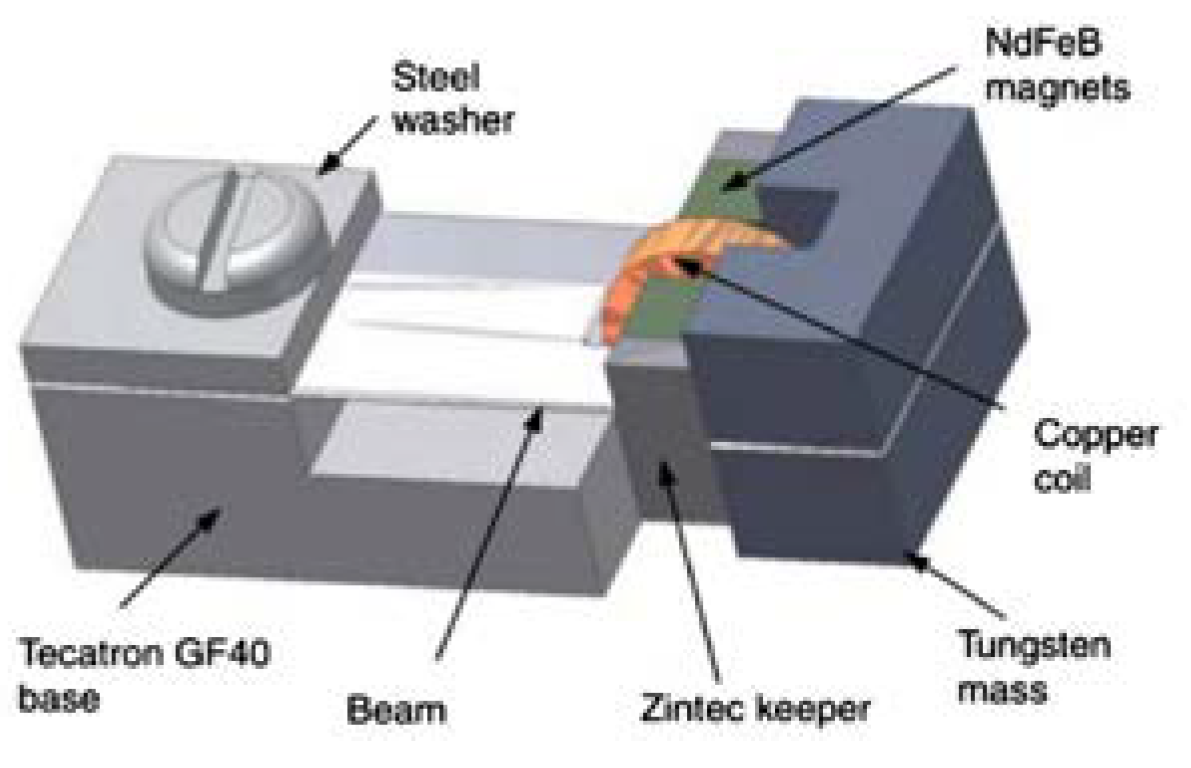Optimal Structural Design of a Magnetic Circuit for Vibration Harvesters Applicable in MEMS
Abstract
:1. Introduction
2. Designing the MG
3. Modeling the MG
4. Selecting the MG Core Design
5. Critical Parameters of the MG Design
- mechanical dynamics;
- electromagnetic field; and,
- electronic systems (power management blocks).
6. Microstructures
7. Comparing MG Concepts, Designs, and Structures
8. Conclusions
Author Contributions
Acknowledgments
Conflicts of Interest
References
- Stratton, J.A. Theory of Electromagnetic Field; Czech Version; SNTL: Praha, Czech Republic, 1961. [Google Scholar]
- Szabo, Z.; Fiala, P.; Dohnal, P. Magnetic circuit modifications in resonant vibration harvesters. Mech. Syst. Signal Process. 2018, 99, 832–845. [Google Scholar] [CrossRef]
- Fiala, P. Vibration Generator Conception; Research Report in Czech; DTEEE, Brno University of Technology: Brno, Czech Republic, 2003; p. 95. [Google Scholar]
- Jirků, T.; Fiala, P.; Kluge, M. Magnetic resonant harvesters and power management circuit for magnetic resonant harvesters. Microsyst. Technol. 2010, 16, 677–690. [Google Scholar] [CrossRef]
- Fiala, P.; Jirků, T. Analysis and Design of a Minigenerator, Progress in Electromagnetics 2008. In Proceedings of the PIERS 2014 in Guangzhou, Guangzhou, China, 25–28 August 2014; pp. 749–753. [Google Scholar]
- Madinei, H.; Khodaparast, H.H.; Adhikari, S.; Friswell, M. Design of MEMS piezoelectric harvesters with electrostatically adjustable resonance frequency. Mech. Syst. Signal Process. 2016, 81, 360–374. [Google Scholar] [CrossRef]
- Scapolan, M.; Tehrani, M.G.; Bonisoli, E. Energy harvesting using parametric resonant system due to time-varying damping. Mech. Syst. Signal Process. 2016, 79, 149–165. [Google Scholar] [CrossRef]
- Gatti, G.; Brennan, M.; Tehrani, M.; Thompson, D. Harvesting energy from the vibration of a passing train using a single-degree-of-freedom oscillator. Mech. Syst. Signal Process. 2016, 66, 785–792. [Google Scholar] [CrossRef] [Green Version]
- Davino, D.; Krejčí, P.; Pimenov, A.; Rachinskii, D.; Visone, C. Analysis of an operator-differential model for magnetostrictive energy harvesting. Commun. Nonlinear Sci. Numer. Simul. 2016, 39, 504–519. [Google Scholar] [CrossRef] [Green Version]
- Saravanan, S.; Dubey, R. Optical absorption enhancement in 40 nm ultrathin film silicon solar cells assisted by photonic and plasmonic modes. Opt. Commun. 2016, 377, 65–69. [Google Scholar] [CrossRef]
- Kulkarni, S.; Koukharenko, E.; Torah, R.; Tudor, J.; Beeby, S.; O’Donnell, T.; Roy, S.; Beeby, S. Design, fabrication and test of integrated micro-scale vibration-based electromagnetic generator. Sens. Actuators A Phys. 2008, 145, 336–342. [Google Scholar] [CrossRef] [Green Version]
- Beeby, S.P.; Torah, R.N.; Torah, M.J.; O’Donnell, T.; Saha, C.R.; Roy, S. A microelectromagnetic generator for vibration energy harvesting. J. Micromech. Microeng. 2007, 17, 1257–1265. [Google Scholar] [CrossRef]
- Zhu, D.; Roberts, S.; Tudor, M.J.; Beeby, S.P. Design and experimental characterization of a tunable vibration-based electromagnetic micro-generator. Sens. Actuators A Phys. 2010, 158, 284–293. [Google Scholar] [CrossRef] [Green Version]
- Elvin, N.G.; Elvin, A.A. An experimentally validated electromagnetic energy harvester. J. Sound Vib. 2011, 330, 2314–2324. [Google Scholar] [CrossRef]
- Wang, P.-H.; Dai, X.-H.; Fang, D.-M.; Zhao, X.-L. Design, fabrication and performance of a new vibration-based electromagnetic micro power generator. Microelectron. J. 2007, 38, 1175–1180. [Google Scholar] [CrossRef]
- Yang, J.; Yu, Q.; Zhao, J.; Zhao, N.; Wen, Y.; Li, P.; Qiu, J. Design and optimization of a bi-axial vibration-driven electromagnetic generator. J. Appl. Phys. 2014, 116, 114506. [Google Scholar] [CrossRef]
- Lee, B.-C.; Rahman, A.; Hyun, S.-H.; Chung, G.-S. Low frequency driven electromagnetic energy harvester for self-powered system. Smart Mater. Struct. 2012, 21, 125024. [Google Scholar] [CrossRef]
- Siddique, A.R.M.; Mahmud, S.; Van Heyst, B. A comprehensive review on vibration based micro power generators using electromagnetic and piezoelectric transducer mechanisms. Energy Convers. Manag. 2015, 106, 728–747. [Google Scholar] [CrossRef]
- Quinn, J.B.; Waldmann, T.; Richter, K.; Kasper, M.; Wohlfahrt-Mehrens, M. Energy Density of Cylindrical Li-Ion Cells: A Comparison of Commercial 18650 to the 21700 Cells. J. Electrochem. Soc. 2018, 165, A3284–A3291. [Google Scholar] [CrossRef]
- Liu, C.; Yu, Z.; Neff, D.; Zhamu, A.; Jang, B.Z. Graphene-Based Supercapacitor with an Ultrahigh Energy Density. Nano Lett. 2010, 10, 4863–4868. [Google Scholar] [CrossRef] [PubMed]
- Zhu, D.; Tudor, M.J.; Beeby, S.P. Strategies for increasing the operating frequency range of vibration energy harvesters. J. Meas. Sci. Technol. 2010, 21, 22001. [Google Scholar] [CrossRef]
- El-Hami, M.; Glynne-Jones, P.; White, N.; Hill, M.; Beeby, S.; James, E.; Brown, A.; Ross, J. Design and fabrication of a new vibration-based electromechanical power generator. Sens. Actuators A Phys. 2001, 92, 335–342. [Google Scholar] [CrossRef]
- ANSYS Users Manual, (1991–2019). USA. Available online: www.ansys.com (accessed on 1 July 2018).
- Fiala, P.; Hadas, Z.; Singule, Z.; Ondrusek, C.; Szabo, Z. A Vibrational Generator for Electric Energy Producing, (in CZ Vibrační Generator pro Výrobu Elektrické Energie). Patent No. 305591-CZ, 12 September 2006. [Google Scholar]
- Fiala, P. Fotovoltaický Element Zahrnující Rezonátor (A Photovoltaic Element with an Included Resonator). Patent No. 303866, 27 January 2011. [Google Scholar]
- Fiala, P.; Szabo, Z.; Marcon, P.; Roubal, Z. Mini-and Microgenerators Applicable in the MEMS Technology, Smart Sensors, Actuators, and MEMS VIII. Proc. SPIE 2017, 10246, 1–8. [Google Scholar] [CrossRef]





















| Reference | Permanent Magnet Type | Generator Body Size x, y, z [m] | Resonant Frequency fr [Hz] | Amplitude Mech. Part A [m] | Output Power Pout [W] | Output Voltage Uout [V] | Load Resistance R [Ω] | Acceleration G, g = 9.81 [m/s] | Effective Power Density [W/m3] |
|---|---|---|---|---|---|---|---|---|---|
| Beeby et al. [12], 2007 | − | 375 mm3 | 52 | − | 2 × 10−6 | 0.428 RMS | 4000 | 0.06 g | ≈6 |
| Zhu et al. [13], 2010 | FeNdB | 2000 mm3 | 67.6–98 | 0.6 × 10−3 | 61.6–156.6 × 10−6 | − | − | 0.06 g | ≈30–80 |
| Kulkarni et al. [11], 2008 | FeNdB | 3375 mm3 | 60–9840 | 1.5 × 10−3 | 0.6 × 10−6 | 0.025 | 52,700 | 0.398–4 g | ≈0.2 |
| Wang et al. [15], 2007 | FeNdB | 256 mm3 | 121.25 | 0.738 × 10−3 | - | 0.06 | - | 1.5 g | - |
| Lee et al. [17], 2012 | FeNdB | 1.4 × 10−4 m3 | 16 | − | 1.52 × 10−3 | 4.8 | 5460 | 0.2 g | ≈10 |
| Yang et al., [16], 2014. | − | 50,000 mm3 | 22–25 | 13.4 × 10−3 | 0.7–2.0 | 110 | 0.6 g | ≈270 | |
| Elvin et al., [14], 2011 | − | 15,000 mm3 | 112 | − | 4 × 10−6 | 0.007 | 986 | - | ≈0.26 |
| MG I [2], 2006 | FeNdB | 90, 40, 30 mm | 20–35 | 50 × 10−6–400 × 10−6 | 70 × 10−3 | 4–60 (300) p-p | 7500 | 0.15–0.4 g | ≈650 |
| MG II [2], 2006 | FeNdB | 50, 27, 25 mm | 17–25 | 50 × 10−6–400 × 10−6 | 19.5 × 10−3 | 6−15 | 5000 | 0.1–0.7 g | ≈60 |
| MG III | FeNdB | 50, 25, 25 mm | 21–31.5 | 50 × 10−6–400 × 10-6 | 5.0 × 10−3 | 1.0–2.5 | 600 | 0.05–0.4 g | ≈15 |
| MG IV | FeNdB | 50, 35, 25 mm | 21–31.5 | 50 × 10−6–400 × 10−6 | 8.0 × 10−3 | 1.0–2.5 | 1200 | 0.05–0.4 g | ≈18 |
| *Lith. battery [19], 2018 | ≈40 × 106 | ||||||||
| *supercap [20], 2010 | ≈3–5 | ||||||||
| *fuel | ≈4 × 109 | ||||||||
| *U235 | ≈9 × 1016 |
© 2020 by the authors. Licensee MDPI, Basel, Switzerland. This article is an open access article distributed under the terms and conditions of the Creative Commons Attribution (CC BY) license (http://creativecommons.org/licenses/by/4.0/).
Share and Cite
Szabó, Z.; Fiala, P.; Zukal, J.; Dědková, J.; Dohnal, P. Optimal Structural Design of a Magnetic Circuit for Vibration Harvesters Applicable in MEMS. Symmetry 2020, 12, 110. https://doi.org/10.3390/sym12010110
Szabó Z, Fiala P, Zukal J, Dědková J, Dohnal P. Optimal Structural Design of a Magnetic Circuit for Vibration Harvesters Applicable in MEMS. Symmetry. 2020; 12(1):110. https://doi.org/10.3390/sym12010110
Chicago/Turabian StyleSzabó, Zoltán, Pavel Fiala, Jiří Zukal, Jamila Dědková, and Přemysl Dohnal. 2020. "Optimal Structural Design of a Magnetic Circuit for Vibration Harvesters Applicable in MEMS" Symmetry 12, no. 1: 110. https://doi.org/10.3390/sym12010110




